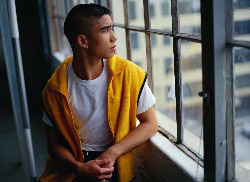 |
 |
 |
 Health & Beauty | July 2005 Health & Beauty | July 2005  
1 in 5 Teens Abused Prescription Drugsr
 Larry Mcshane - Associated Press Larry Mcshane - Associated Press


| | Study shows U.S. teens increasingly trying prescription drugs. |
About one in five teenagers have tried prescription painkillers such as Vicodin and OxyContin to get high, with the pill-popping members of "Generation Rx" often raiding their parents' medicine cabinets, according to a study by the Partnership for a Drug-Free America.

The 17th annual study on teen drug abuse, released Thursday, found that more teens had abused a prescription painkiller in 2004 than Ecstasy, cocaine, crack or LSD. One in 11 teens had abused over-the-counter products such as cough medicine, the study reported.

"For the first time, our national study finds that today's teens are more likely to have abused a prescription painkiller to get high than they are to have experimented with a variety of illegal drugs," said Partnership Chairman Roy Bostock. "In other words, Generation Rx has arrived."

According to the study, the most popular prescription drug abused by teens was Vicodin, with 18 percent or about 4.3 million youths reporting they had used it to get high. OxyContin and drugs for attention-deficit disorder such as Ritalin/Adderall followed with one in 10 teens reporting they had tried them.

Fewer than half the teens 48 percent said they saw "great risk" in experimenting with prescription medicines. "Ease of access" was cited as a major factor in trying the medications, with medicine cabinets at home or at friends' homes a likely source, the survey found.

It was only the second year that the survey had studied abuse of legal drugs. In 2003, the Partnership grouped together three prescription pain relievers: Vicodin, OxyContin and Tylox, and found that 20 percent of teens had tried them.

The 2004 study looked at Vicodin and OxyContin separately but excluded Tylox, and found that 18 percent had tried Vicodin and 10 percent had used OxyContin. The 2004 figures indicated the same or a slight increase in use compared with 2003, said Barbara Delaney, director of research at the Partnership.

For the first time, the 2004 survey included a question about the use of over-the-counter products to get high. Nine percent, or about 2.2 million teens, had experimented with cough syrup and other such products, the survey reported.

It also found that the number of teens reporting marijuana use declined to 37 percent last year, compared with 42 percent a half-dozen years earlier. Over the same amount of time, ecstasy use declined from 12 percent to 9 percent, while methamphetamine use dropped from 12 percent to 8 percent.

A University of Michigan study released in December also noted the apparent growing popularity of OyxContin among teens. Dr. Mitchell Rosenthal, head of the Phoenix House drug treatment facility, said his agency has watched the use of painkillers by adolescents rise in recent years.

"Adolescents find the line between drugs that do good for you and drugs that make you feel good becoming fuzzier every year," said Rosenthal, whose non-profit organization treats 6,000 patients in nine states. "This is a wake-up call to parents."

The 2004 Partnership Attitude Tracking Study surveyed more than 7,300 teens, the largest ongoing analysis of teen drug-related attitudes toward drugs in the country. Its margin of error is plus or minus 1.5 percent.

The 2004 Partnership Attitude Tracking Study surveyed more than 7,300 teens, the largest ongoing analysis of teen drug-related attitudes toward drugs in the country. Its margin of error is plus or minus 1.5 percent.

The nonprofit Partnership for a Drug-Free America was launched in 1987.

On the Net: http://www.drugfree.org Partnership for Drug Free America | 
 | |
 |



